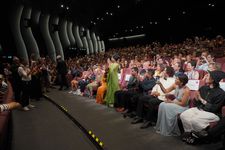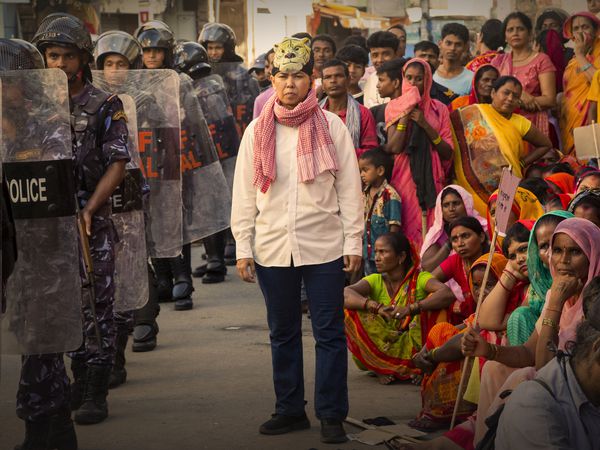Rauniyar says: “Asha is from the light-skinned Pahadi ethnic group, while I am from the dark-skinned Madhesi ethnic group. We were inspired by our marriage and we wanted the point of view of Pooja, who is an outsider - that was the central structure of the film.”
Speaking about the various layers of discrimination that many people face, he adds: “It's really hard to separate in Nepal, what is gender, or what is caste, or what is class or race. It's always mixed up and very hard to look at separately, because you could be lower caste, but if you are rich you get treated differently, and you could be a woman, but if you come from a rich family or you hold a powerful post, you are a different person than someone who doesn't have the same capability.
“I think it's sometimes hard to say, like, if someone misbehaves towards me, is it because I am a Madhesi or is it because of my language and they spotted it, or is it because I was walking and I was not in a car. If I'm walking to an office or I take a car, even if it could be a rented one, if they didn't know if it was rented, they would have a totally different reaction to it.
“That happens even in the US, we were joking last month, we had rented a Tesla and stopped at a Nepali store and the treatment of that Nepali store of us was so different and we never had that before.”
The film uses an almost reportage style at times and Rauniyar notes that they wanted to be “close to the character but also wide enough that other elements are in the frame as well”.
He adds: “That's why we went for anamorphic and we went for these lenses and shot entirely in the wide but we were always with the characters, because, how we grew up in Nepal is that you're always super-conscious about what is happening around you. How you're being looked at is always in your mind and so we wanted to bring that feeling in some way. And so we decided we would be inside the crowd, inside our character’s head, and go through how they're feeling, but they're also conscious of how they’re being perceived.”
There were also some logistical challenges of shooting some of the exterior scenes, which involved a lot of extras, even though they were able to shut down various streets.
“With some of the main scenes we were able to close down certain areas – not the whole town, because it's a very crowded town and we didn’t have the budget. There is no studio set in Nepal where you can go and shoot this kind of thing so you have to do it in a real street.
“The extras were not trained actors, so they are real people coming to the shoot. Sometimes they're curious about how the camera looks and they're looking in the camera, so that needed a lot of management and long takes. Sometimes they were seven or eight minutes long. But the crew were really fantastic.”
The filmmakers were also grateful to the local community. “A lot of these shoots happened in the early morning when the town was still waking up, because we didn't have the budget to lock down everything, and locals and the police were really supportive of that happening.
“We were very scared that if we shot there, where there had been a traumatic protest for several months, how the people were going to react to it, but people were happy that we're making a film about them, and someone came to listen to what had happened and recreate it. So we were really surprised when we found that they were distributing water to our crew and cast, and I think before that, we were really concerned about how they're going to react to it. So we were really glad about that.”
 |
| Asha Magrati and Deepak Rauniyar with Venice artistic director Alberto Barbera Photo: Andrea Avezzu/La Biennale di Venezia/Foto ASAC |
She also reveals that she opted for a spot of method acting in a key scene in which Pooja is given incredibly spicy food by a Madhesi policewoman she is working with as a sort of pay back.
“I wrote that scene and I killed myself,” she says, laughing, as she recalls that they gave her incredibly spicy food to eat.
One of the constants in the work of Rauniyar and Magrati – who previously made features White Sun and Highway together, along with a clutch of short films – is the recurrence of Pooja as a character name. It’s a name that means “to honour or worship”.
Rauniyar adds: “In Nepal, and for Hindus especially culturally, we believe that a daughter is a Goddess, and that’s something that we really respect in our family and we also have a lot of female gods that we pray to. But in contradiction to that is we only like them when they don't talk or don't ask questions. Once they start asking for something, start asking for equal rights, it’s different.
“Nepal is one of those countries where mothers cannot pass citizenship to their children, a man has to certify the children to be able to get citizenship in the country. You cannot get citizenship just because you were born in that country. So for us, it was a kind of reminder that we decided to, from our very first film, to use the name Pooja, as a reminder for ourselves that we have not overcome that. There is still that double role, where we talk about how we really respect our daughter, we “pooja” our daughter, but on the other side, we don't actually do it.”
That conflict is very evident in the film, which shows Pooja in her domestic environment before she leaves for the case. There, her ailing father expects her to take on the traditional female role and baulks at being left at home to be cared for by the police officer’s female partner.
Rauniyar and Magrati spent several years doing research, including talking to a lot of police officers, who let them into their homes and opened up about their lives. Additionally, they drew on their own lives.
Rauniyar adds: “This character borrows a lot from Asha’s real life. Her brother died early when he was only 23 or 24 years old, and she helped raise two of his daughters. Because her brother died, her mother and father always thought about how they don't have a son any more, so who is going to cremate them? What is going to happen? Who is going to take care of them? So Asha kind of took care of that role of a son in the family growing up. So our personal biographical information became mixed with the experiences of the people we were interviewing.”
 |
| Crowd applaud Asha Magrati in Venice Photo: Andrea Avezzu/La Biennale di Venezia/Foto ASAC |
Magrati says it's really helpful for the two of them to be working on the same projects.
She adds: “When you are tired, then you are sharing it and you feel a bit more fresh. When you have a new idea there is always a person you can share it with. Those are the plus points.”
Rauniyar says: “For us it’s been a 24-hour collaboration and it's been helpful. I always think I'm more creative when I have someone to talk to, and someone I can discuss with, someone can question me – I think questions really help me to be clear. So it feels for me, like a luxury or a gift as a filmmaker, to have a partner that you can talk to all the time, in what can be a very lonely business.”
Magrati also says the pair of them have “totally different talents” which means that when they put them together they complement one another. She says: “His background is journalism, so he’s really good at structure but I have a really good sense for observations and small details because I’m from a theatre background. We do have different qualities. Maybe because of that, we are still working together.”
Now the pair of them are based in Boston, Massachusetts, in the US, which they say is helpful in terms of money. Both teach and do other work between their films together. Rauniyar says it also helps them to be more objective in their work on Nepal, saying he was able to compare some of the things happening in his homeland with the Black movement in the US.
Looking to the future, Rauniyar adds: “We’re developing two films, one set in London, and one is in New York, and both connected to Nepal in some way.”
Watch the trailer:






















